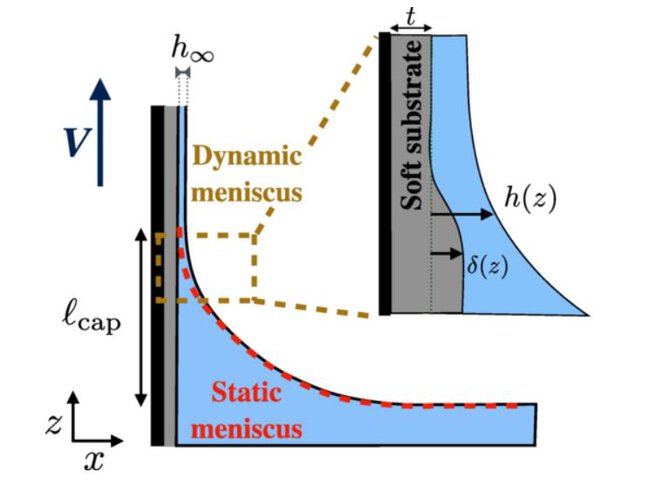 A solid, withdrawn from a wetting liquid bath, entrains a thin liquid film. This simple process, first described by Landau, Levich, and Derjaguin (LLD), is commonly observed in everyday life. It also plays a central role in liquid capture by animals, and is widely used for surface-coating purposes in industry. Motivated by the emerging interest in the mechanics of very soft materials, and in particular the resulting elastocapillary coupling, we develop a dip-coating model that accounts for the additional presence of a soft solid layer atop the rigid plate. The elastic response of this soft layer is described by a Winkler’s foundation. Using a combination of numerical, scaling, and asymptotic-matching methods, we find a new softness-dependent power-law regime for the thickness of entrained liquid at a small capillary number, which corresponds to a modified physics at play in the dynamic meniscus. The crossover between this regime and the classical dip-coating one occurs when the substrate’s deformation is comparable to the thickness of the entrained liquid film.
A solid, withdrawn from a wetting liquid bath, entrains a thin liquid film. This simple process, first described by Landau, Levich, and Derjaguin (LLD), is commonly observed in everyday life. It also plays a central role in liquid capture by animals, and is widely used for surface-coating purposes in industry. Motivated by the emerging interest in the mechanics of very soft materials, and in particular the resulting elastocapillary coupling, we develop a dip-coating model that accounts for the additional presence of a soft solid layer atop the rigid plate. The elastic response of this soft layer is described by a Winkler’s foundation. Using a combination of numerical, scaling, and asymptotic-matching methods, we find a new softness-dependent power-law regime for the thickness of entrained liquid at a small capillary number, which corresponds to a modified physics at play in the dynamic meniscus. The crossover between this regime and the classical dip-coating one occurs when the substrate’s deformation is comparable to the thickness of the entrained liquid film.
(Abstract)
PHYSICAL REVIEW FLUIDS
Volume 7 / Issue 10 / Article Number L102002
Published OCT 2022
DOI10.1103/PhysRevFluids.7.L102002
https://arxiv.org/pdf/2203.00322.pdf
By: Vincent Bertin, Jacco H. Snoeijer, Elie Raphaël, Thomas Salez

